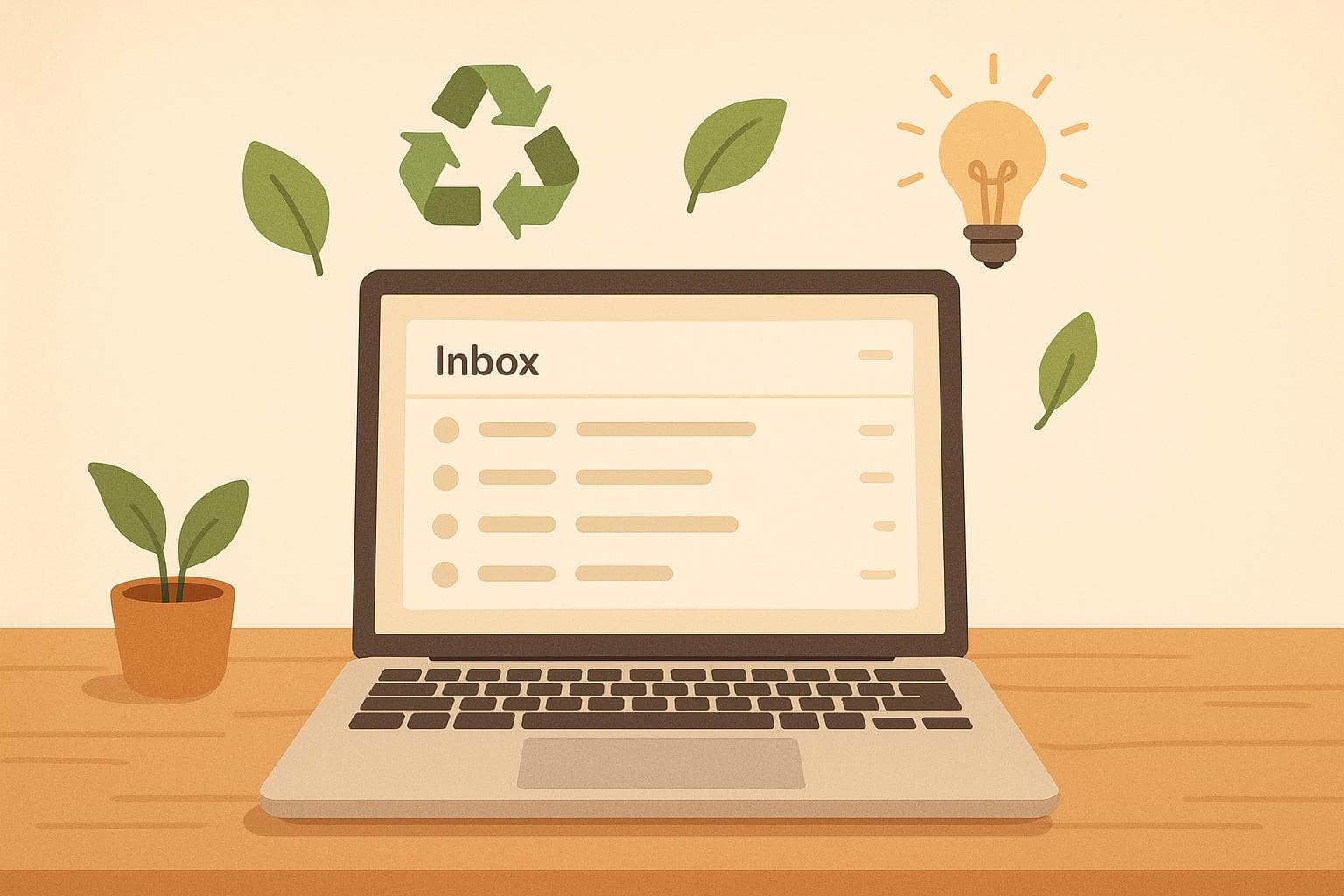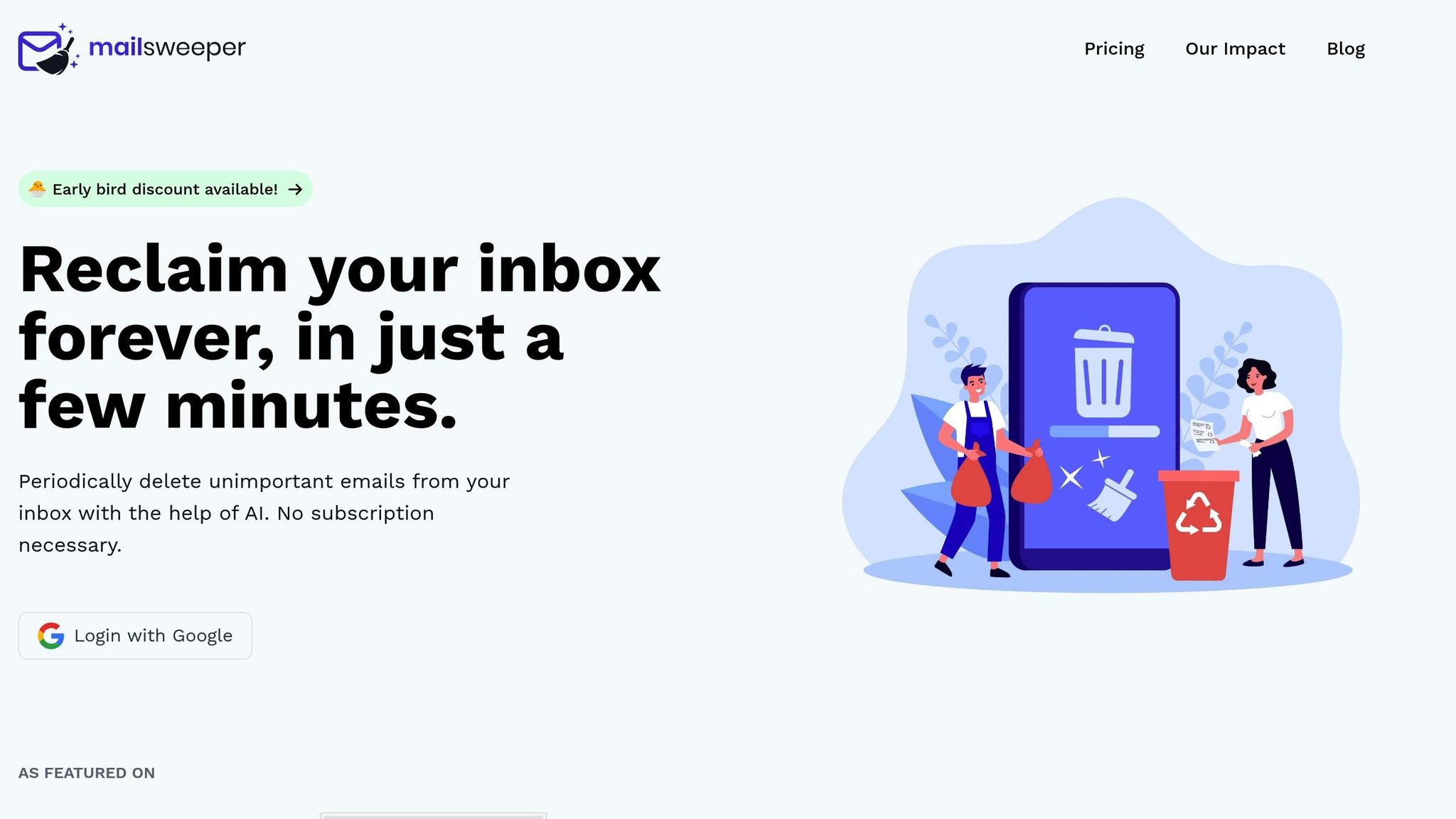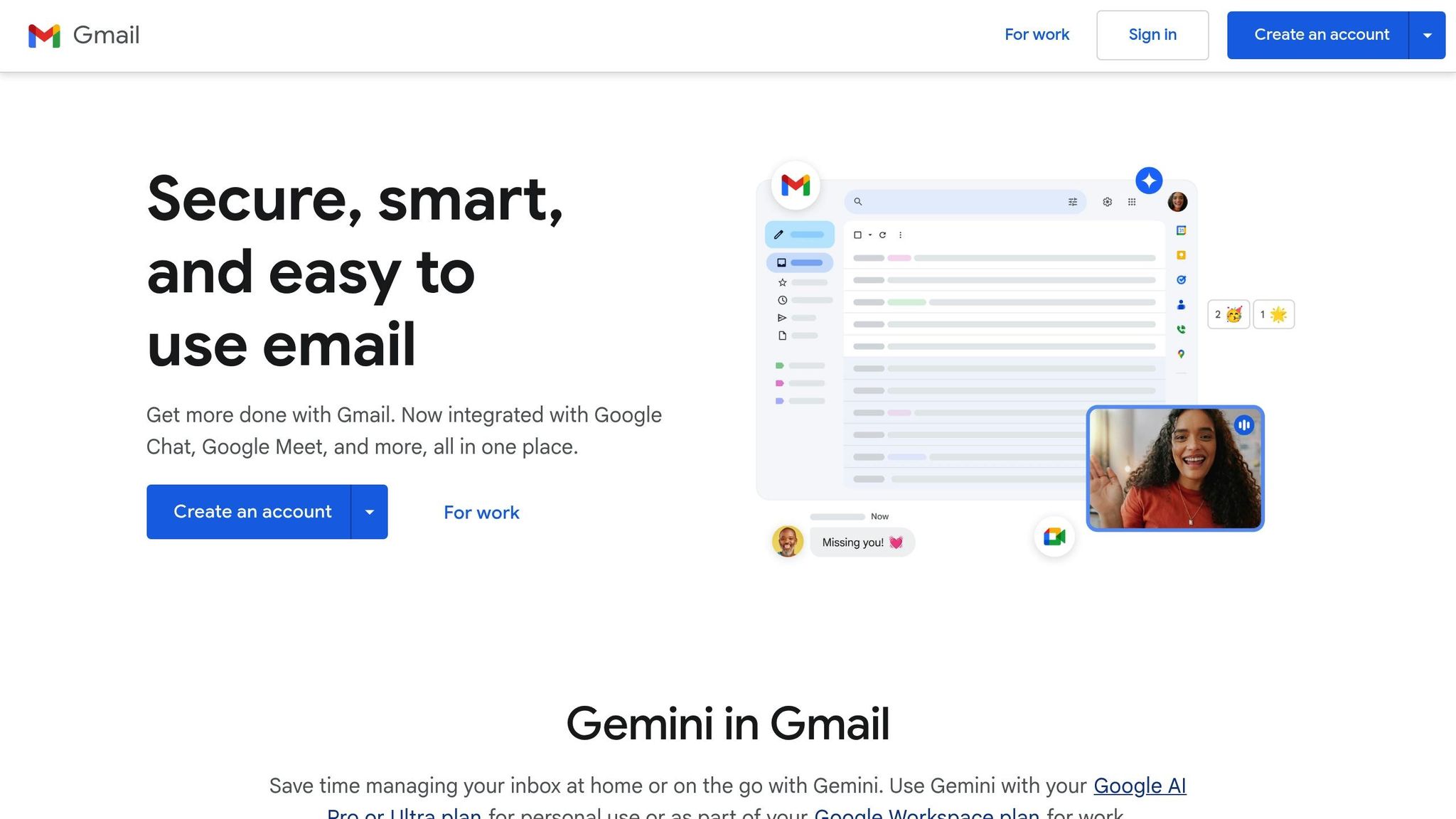Email Management
Reduce Email Energy Use: Tips
Learn simple strategies to reduce the energy consumption of your email inbox and minimize your carbon footprint.

Reduce Email Energy Use: Tips
Every email you send or store uses energy, contributing to carbon emissions. While a single email's impact may seem small, the billions sent daily add up. Here’s how you can reduce your email’s energy use and lighten your inbox:
- Delete old emails: Free up storage and cut energy consumption.
- Unsubscribe from spam: Stop unwanted emails from wasting resources.
- Avoid large attachments: Use links or compress files to save energy.
- Limit "Reply All": Fewer recipients mean less energy use.
- Automate cleanup: Tools like MailSweeper can simplify inbox management.
Simple changes like these can reduce your digital footprint while keeping your inbox organized. Start small - delete 50 old emails or unsubscribe from a few newsletters today. Millions making small changes can create a big impact.
What Is The Hidden Energy Cost Of Your Email Inbox? - Minimalist Home Life
How Emails Impact the Environment
Every email you send or receive comes with an environmental cost. Behind the scenes, emails rely on networks and data centers that operate non-stop, consuming energy for processing, cooling, and storage. This constant activity adds up, creating a noticeable ecological impact.
Energy Costs of Email Storage
Emails don’t just disappear into thin air - they’re stored in data centers that run 24/7. These facilities not only power servers but also use energy-hungry cooling systems to prevent overheating. Larger emails, especially those with hefty attachments or high-resolution images, take up more storage space and require more energy. Even emails you never open - like old promotional offers - contribute to this energy drain.
Energy Used in Email Transmission
Sending an email isn’t as simple as it looks. When you hit "send", your message travels through multiple network checkpoints before reaching its recipient. Each step in this process consumes energy. Add large files or group emails into the mix, and the energy use climbs even higher. Spam filters also play a role, as they require additional resources to screen emails.
U.S. Examples of Email Carbon Footprint
In the United States, where email usage is widespread, the environmental impact of emails becomes even more apparent. While the energy cost of a single email might seem small, multiplying it by the millions sent daily paints a different picture. Simple actions like cutting down on unnecessary emails and organizing your inbox can help reduce this digital energy burden. These small changes pave the way for practical ways to shrink your digital carbon footprint.
Ways to Reduce Email Energy Use
You can lower your email's energy impact by tweaking a few everyday habits. These small adjustments not only help the environment but also streamline your inbox. Here are some practical tips to get started.
Delete Old and Unnecessary Emails
Clearing out your inbox can significantly cut down on energy waste. For example, storing 3,500 emails of 5MB each produces CO2 emissions equivalent to driving 0.6 miles. Plus, maintaining one gigabyte of email storage uses 32 kWh of electricity. On a global scale, deleting just 10 emails per person could free up 1,725 GB of storage. Begin with the easiest targets - old promotions, outdated work emails, and unread notifications. Dedicate just 15 minutes a week to deleting emails older than six months, and you’ll help reduce server loads and energy consumption.
Unsubscribe from Spam and Unwanted Newsletters
Unwanted emails aren’t just annoying - they waste energy. Each spam email filtered out still uses about 0.03 grams of CO2e. Considering there are 300 billion emails sent globally each day, the environmental impact adds up fast. Take a moment to unsubscribe from newsletters and notifications you no longer read. This simple step not only reduces energy use but also keeps your inbox more organized.
Keep Attachments and Email Sizes Small
Attachments are energy hogs. While a plain text email generates just 0.3 grams of CO2e, an email with a large attachment can produce up to 50 grams. Instead of sending large files directly, use cloud storage links or file-sharing services. Compress files and resize images before attaching them - this can reduce file sizes by 70–90% without noticeably affecting quality. These small tweaks go a long way in conserving energy.
Minimize Email Chains and "Reply All"
Long email threads and unnecessary replies also contribute to energy waste. For example, a lengthy email can emit as much as 17 grams of CO2e. Before hitting "Reply All", ask yourself if every recipient really needs to see your response. Often, replying to just the sender or a smaller group is enough. The impact of this habit can be surprisingly large - if every adult in the UK sent one less "thank you" email, it would save emissions equivalent to 81,152 flights to Madrid.
Using MailSweeper for Email Cleanup

Tired of manually sifting through emails to clean up your inbox? Automation can step in to save time and energy. By automating your email cleanup, you can reduce unnecessary data storage and transmission, helping to lower energy consumption.
How MailSweeper Works
MailSweeper leverages artificial intelligence to identify and delete emails you don't need, sending them straight to the trash. During the setup process, you'll answer a few simple questions to customize the AI based on your preferences. It integrates effortlessly with your Google account and operates quietly in the background. While it filters out emails that contribute to excess energy use, it ensures your important communications stay intact - anything starred, marked as important, or stored in your primary inbox is never deleted.
MailSweeper Features and Benefits
MailSweeper is packed with features that aim to reduce energy costs while keeping your essential emails safe. It’s CASA certified, which guarantees that your email data is never read, stored, or sold. For a one-time fee of $20, the Personal plan offers lifetime access. You can fine-tune the cleanup process to suit your needs - choose an aggressive approach to clear out promotional emails quickly or opt for a more gradual method that targets only older messages. This flexibility, combined with automation, helps cut down on data storage and transmission costs.
Benefits of Using MailSweeper
So far, MailSweeper has removed 195 GB of email storage and reduced carbon emissions by 88.60 kgCO2e. Across all users, the tool has swept through 2,698,951 emails. It also includes a personal impact dashboard, where you can monitor the number of emails cleaned, storage space freed, and your individual contribution to reducing energy use. This feature makes it easy to see the direct impact of your efforts. By automating the cleanup process, MailSweeper not only keeps your inbox tidy but also saves you time - no more manual deletions. Plus, it works seamlessly alongside Gmail’s built-in energy-saving tools, offering a comprehensive solution for a cleaner, greener inbox.
sbb-itb-34b9fd2
Gmail Storage Tips for Energy Savings

Gmail offers several tools and features that can help you manage storage efficiently while also reducing energy consumption. When combined with automated solutions, these tools provide a practical way to keep your inbox organized and eco-friendly.
Using Gmail's Built-In Tools
Gmail’s search functionality is a powerful ally when it comes to identifying emails that take up the most space. You can use search commands like has:attachment larger:10M to find emails with large attachments or older_than:1y to locate older messages. For even more precision, combine these commands, such as has:attachment older_than:6m, to quickly pinpoint storage-heavy emails. Adjust the size filter (e.g., "10M", "5M", or "1M") based on your needs.
Additionally, Gmail’s storage page provides an overview of how much space is being used across Gmail, Google Drive, and Photos. Since Google offers 15 GB of free storage, it’s easy to hit the limit if you don’t regularly clean up your inbox. Deleting unnecessary emails can help you avoid paying for additional storage.
Setting Up Automated Filtering and Archiving
Gmail’s filtering feature can save you time by automating email management. Filters let you set specific rules for handling incoming messages, which helps reduce clutter and the energy impact of storing unwanted emails.
To create a filter, open Gmail and click the "Show search options" arrow in the search bar. Enter criteria like sender or keywords, then click "Create filter" to set actions such as archiving or deleting matching emails. For example, you can filter promotional emails by including terms like "unsubscribe" or "promotional" in the criteria.
Here are some filter actions to consider for reducing storage:
- "Skip the Inbox (Archive it)": Moves emails out of your main inbox but keeps them accessible.
- "Apply the label:": Organizes emails into specific folders for easier management.
- "Delete it": Sends unwanted messages straight to the trash.
If you want to clean up existing emails, check the box for "Also apply filter to matching conversations" when creating a filter. You can even create filters from specific emails by selecting a message, clicking the "More" icon (three vertical dots), and choosing "Filter messages like these". Gmail will automatically fill in the search criteria based on the selected email, making the process quicker.
Scheduling Regular Inbox Cleanups
Routine maintenance is key to keeping your inbox tidy and minimizing unnecessary energy use. Consider setting a monthly reminder to review and delete emails you no longer need, especially those with large attachments or lengthy email chains.
Focus on specific categories like notifications, receipts, and confirmations by using relevant keywords. You can also review Gmail’s "Promotions" and "Updates" tabs periodically and delete entire conversations rather than individual messages to save time.
For emails you may want to reference later, consider archiving them instead of leaving them in your primary inbox. While archived emails still take up storage, they help declutter your inbox, making it easier to focus on current priorities without the distraction of unnecessary messages. This approach not only keeps your inbox organized but also contributes to lowering your digital energy footprint.
Comparing Email Cleanup Methods
When it comes to cutting down your email's energy footprint, there are a few methods you can explore. Each option comes with its own set of advantages, depending on how tech-savvy you are, how much time you can dedicate, and the size of your inbox. By understanding these methods, you can choose the one that fits your needs best.
Cleanup Methods Comparison Table
| Method | Ease of Use | Time Required | Cost | Effectiveness | Energy Impact |
|---|---|---|---|---|---|
| Manual Cleanup | Moderate | High (2–4 hours/month) | Free | Variable | Low to Moderate |
| Gmail Built-in Tools | Easy | Moderate (30–60 minutes setup) | Free | Good | Moderate |
| MailSweeper | Very Easy | Low (about 5 minutes setup) | $20 one-time | Excellent | High |
Manual cleanup gives you complete control over your inbox, but it’s time-consuming and results can vary. Gmail’s built-in tools, like search commands and filters, are more user-friendly and deliver good results with occasional updates. Meanwhile, MailSweeper automates the process with a quick setup and provides long-term benefits for a one-time $20 fee, saving you time while reducing storage needs.
Choosing the Best Method for Your Inbox
The right cleanup method depends on how many emails you receive daily and how you like to manage your inbox.
- Manual Cleanup: If you get fewer than 50 emails a day and enjoy organizing your digital space, this method is a solid choice. It’s also ideal if you need to retain specific emails due to compliance or personal preferences. However, it requires constant effort to stay effective.
- Gmail Built-in Tools: For those handling 50–200 emails daily, Gmail’s search and filter tools strike a good balance between manual effort and automation. It’s a great option if you’re comfortable setting up and tweaking filters, though it does require occasional maintenance.
- MailSweeper: If your inbox is flooded with 200+ messages daily or you simply don’t have the time to manage it manually, MailSweeper is a hassle-free solution. It adapts to your email habits, working in the background to keep your inbox organized and energy-efficient without requiring ongoing input.
While manual cleanup and Gmail tools can be effective, they demand varying levels of effort and upkeep. MailSweeper, on the other hand, offers a hands-off approach, automatically ensuring a consistently streamlined and energy-efficient inbox. Choose the method that aligns with your email habits and priorities to make a meaningful impact.
Conclusion: Simple Steps, Big Impact
Cutting down your email's energy use doesn't take much - just a few thoughtful tweaks can lead to noticeable results. By deleting old emails, unsubscribing from newsletters you don't read, avoiding large attachments, and minimizing unnecessary email chains, you can make a difference for both your inbox and the environment.
Here’s a perspective: a single 1 MB email generates about 3.5 grams of CO₂, and with billions of emails sent daily in the U.S., even small changes add up. For instance, unsubscribing from 10 unwanted newsletters can save up to 39 grams of CO₂ each year. Multiply that by millions of users, and the collective impact becomes substantial.
You can choose the cleanup method that works best for your routine. Whether you like manually tidying up, using Gmail's filtering tools, or letting MailSweeper's AI-powered system handle it all for you, the key is to stick with a system that fits your lifestyle. For those juggling 200+ emails daily, MailSweeper offers a hands-free solution that ensures consistent results without extra effort.
Beyond the environmental perks, these changes streamline your inbox, save time, and even cut down on storage costs. It’s a simple approach that benefits both you and the planet.
Ready to start? Try deleting 50 old emails, unsubscribe from three newsletters you never read, or set up MailSweeper to automate the process. When millions take these small steps, the collective effort leads to a more sustainable digital world. Your inbox - and the environment - will thank you.
FAQs
How does deleting old emails help save energy and reduce carbon emissions?
Reducing the clutter in your email inbox isn’t just about staying organized - it can actually help conserve energy and cut down on carbon emissions. Here’s how it works: when you delete old emails, you reduce the amount of data that email servers need to store and manage. With less data to handle, these servers use less energy for processing, storage, and upkeep.
This small action has a bigger impact than you might think. Data centers, which power email servers, are heavy energy users and play a notable role in global energy consumption. By cleaning up your inbox, you’re contributing to a more energy-efficient system and taking a simple step toward reducing your digital carbon footprint.
How does sending large email attachments impact the environment, and is using cloud storage links a better option?
Sending large email attachments might seem harmless, but it actually consumes more energy and adds to your carbon footprint. Every large file you attach generates CO2 emissions - comparable to driving a few miles in a car. Why? Because storing and transmitting those hefty files requires extra energy from servers and networks.
A smarter, greener alternative is to use cloud storage links. Cloud services are designed to be more energy-efficient, and sharing a link eliminates the need to send bulky files directly through email. By opting for cloud links, you can cut down on energy consumption and make your digital communication a bit kinder to the planet.
How does using an automated tool like MailSweeper help reduce the environmental impact of email usage?
Automated tools like MailSweeper offer a practical way to cut down the energy demands of email usage by simplifying inbox management. They identify and remove unnecessary emails, which in turn reduces the energy needed for data storage and processing in data centers.
By tackling digital clutter, these tools help lower energy consumption and shrink the digital carbon footprint. They provide a straightforward solution for individuals and organizations to stay organized while contributing to sustainability efforts.
